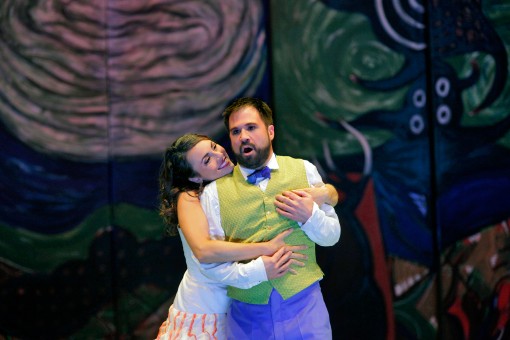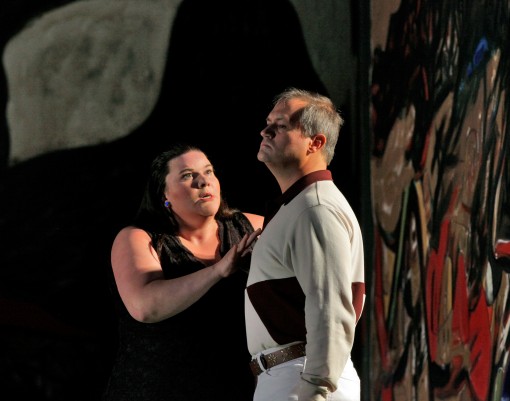Vivaldi’s music and inspired cast trump bewildering plot in Santa Fe Opera’s “Griselda”

Isabel Leonard as Costanza and David Daniels as Roberto in Vivaldi's "Griselda" at Santa Fe Opera. Photo: Ken Howard
It may be hard for younger aficionados to conceive of a not-too-distant time when Handel’s operas were more talked about than performed — his stage works considered by many as impractical theater curios that were largely the purview of a few specialist cognoscenti on LP.
The state of Handel opera fifty years ago is similar to that of his Italian contemporary Antonio Vivaldi today. As with Handel, Vivaldi’s operas are chockablock with sensational music but, like Handel’s stage works, hobbled by archaic settings, stilted stage action and improbable scenarios.
Give Santa Fe Opera credit for being in the forefront of the burgeoning Vivaldi opera revival by presenting Griselda, heard Thursday night, the company’s debut production of a Vivaldi opera.
The story is one of those 17th-century plots that border on sexual and emotional sadism. King Gualtiero of Thessaly decides to test his unpopular wife Griselda’s fidelity by an elaborate hoax, throwing her out of the kingdom and pretending to marry Costanza, who is their actual daughter. This is unhappy news to her fiancée Roberto, but welcome news to the villainous Ottone who tried to abduct Griselda’s son to work his own dark designs on the ousted queen.
The plot’s Byzantine twists and turns grow ever more complicated to the point that halfway through you just give up. There are few genuine love arias or light moments in an opera where most characters are in acute emotional distress for nearly three hours. What Griselda does offer is much terrific music boasting several bravura arias and lyrical set pieces that rival anything in Handel’s oeuvre.
Peter Sellars’ production for Santa Fe Opera made a game attempt at finessing the inherent challenges of mounting this static Vivaldi opera. And while the difficulties of presenting this problematic work in a compelling manner were not wholly surmounted, a largely excellent cast provided enough moments of stellar singing that it made up the balance — just — for the stultifying action (or lack thereof). But it was close.
Griselda is clearly Santa Fe’s cost-saver this season and Sellars didn’t have much budget to work with in a stripped-down almost bare “production.” The sole design is a cosmically ugly, retina-damaging painted backdrop by the L.A. artist who calls himself Gronk, which looks like it was rendered by one of the less talented New York subway graffiti artists, circa 1971. (Memo to opera producers: Hiring young artists who give themselves phony single names as set designers—probably not a great idea.) Except for Costanza’s elegant gowns, Dunya Ramicova’s garish costumes were on the same tacky level.
By his standard, Sellars’ direction was relatively restrained and intimate, apart from the usual unmotivated floor-rolling and bizarre hand gestures that he inexplicably encourages singers to indulge in. Still, even with about 25 minutes trimmed, the visual ennui of the garish unit set, acres of dizzying recitative, and terminal earnestness of the characters and lack of (intentional) humor proved deadening over the 2-1/2 hour span. (This is one opera that would benefit from some post-modern irony.) Sellars did what he could with the intractable material, jazzing things up in modern-dress fashion with spy v. spy trenchcoats and pointed revolvers while isolating the characters’ emotions in their arias. The staging of the final scene felt just right with the brief rejoicing chorus taking place offstage and Griselda left alone, reduced to a charwoman who sadly sweeps the floor.
Genuine star quality is a rarity on the opera stage — or anywhere — but it’s abundantly clear that Isabel Leonard has it in spades. A charismatic Cherubino for Santa Fe two summers ago, the young mezzo-soprano dominated the production Thursday night as Costanza.
A radiant presence onstage, Leonard brought a touching sincerity and conviction to the plot’s ludicrous twists and turns and proved vocally faultless. She sailed through the coloratura roulades of Costanza’s showpiece, Agitata da due venti, with refined tone and dazzling bravura. The introspective set piece, Ombra vane, sagged a bit at an extremely slow tempo, but Leonard’s singing was extraordinary, with an expressive poise, rarefied pianissimos, and dynamic detailing that are the stuff of great artistry.

Meredith Arwady (Griselda) and Paul Groves (Gualtiero) in Santa Fe Opera's "Griselda." Photo: Ken Howard
As Gualtiero, tenor Paul Groves made a solid attempt at conveying the odious king, stomping around and blustering convincingly. Vocally, however, the Santa Fe regular seemed grievously miscast and painfully overparted in the coloratura fireworks of his opening aria, Se ria procella.
In the role of Gualtiero’s abused and long-suffering wife, Meredith Arwady can’t do much more than look pained throughout the long evening. Vocally, Arwady showed that she is that rarity, a genuine contralto. Her singing was largely impressive, with a rich, dusky tone, evenly produced if not always controlled, with daunting power in the low notes.
Unfortunately, even though she’s the title character, Griselda doesn’t get the best music. So, in a bizarre bit of textual revisionism, Sellars inserts the opening of Vivaldi’s Stabat Mater to give Arwady a better showpiece than the opera actually offers. Arwady brought expressive power and vocal refinement to the insert, but even for an intractable opera like this, Sellars’ do-it-yourself musical retooling is a bit much.
As Roberto, Costanza’s discomfited lover, David Daniels was his usual exemplary self—dramatically credible and vocally first-class, his agile, fluent countertenor impressive throughout.
Amanda Majeski was tasked with the thankless role of the villain Ottone, in love with Griselda who threatens to kill her son unless his love is reciprocated. The gifted young soprano had to labor under Rumikova’s lame hipster-slacker getup, yet brought superb technique and sterling vocalism to her arias. Similarly, while having to wear a hideous green suit, Yuri Minenko as Corrado, Gualtiero’s friend and Roberto’s brother, displayed a clear and flexible countertenor in his brief opportunities.
Some over-indulgent tempos in slow arias apart, conductor Grant Gershon proved a supremely stylish advocate in the pit for this score. The playing Gershon drew from the reduced chamber orchestra was a model of good Baroque and – seemingly — Vivaldi manners with crisply pointed accents, buoyant rhythms and expressive phrasing.
Griselda will be repeated August 9 and 19. santafeopera.org; 800-280-4654
Posted Aug 10, 2011 at 1:30 pm by Tommy T.
The Emperor Has No Clothes!!
Two thoughts in addition to the absolutely “right-on” review above:
First:
Not mentioned was the atrocious lighting which seemed usually to be focused not on the featured soloist but on some far and empty corner of the set. When lights were on artists, they were generally tight spots focused below the belt. (My wife is a professional theatre lighting director with Boston and New York credits and she asserts that was not a single well designed lighting cue in the entire show.)
Second:
Seller’s camp treatment of established works that we have all frequently frequented(Mozart comes to mind) is sometimes fun, amusing or revalatory. In the case of Vivaldi, most of us have few preconceptions of the work and would perhaps have benefited more from an informed performance based on the staging conventions for which Vivaldi wrote. (Most of us sit through full perfomances of The Messiah over and over.)
I’m a trumpet player and could not stop considering how I would play the Vivaldi Concerto for Two Trumpets while lying on my back in the dark with machine gun carrying super-numeraries running around the stage.